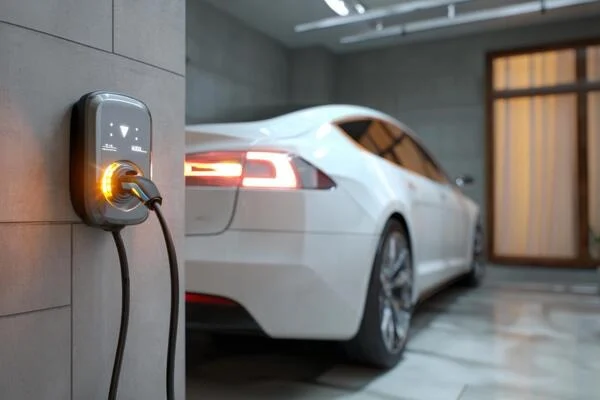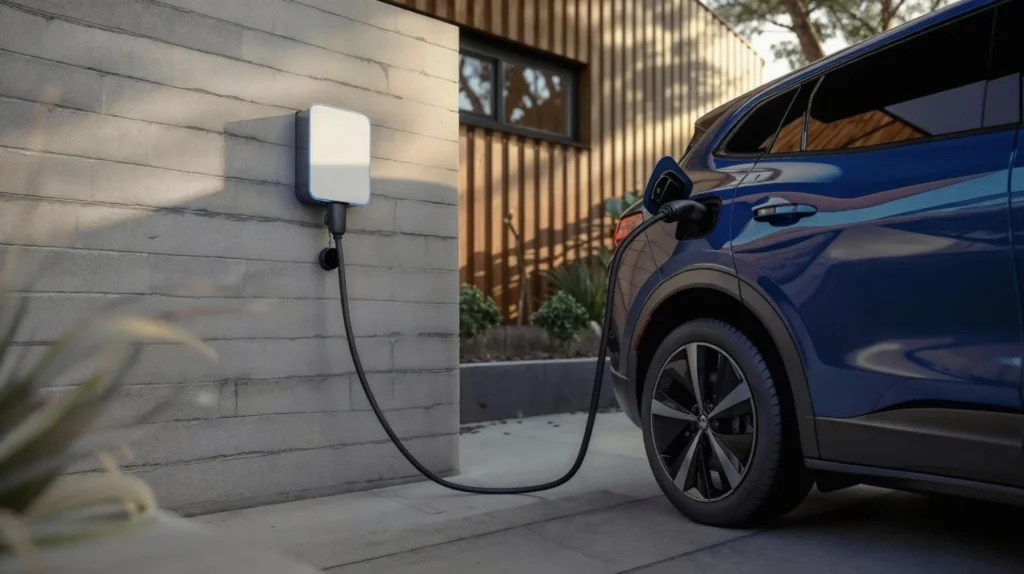The rise of electric vehicles takes it too fast for a home-charging setup to be considered anything less than a modern amenity. Thus, an EV charger installed in the garage not only affords convenience but also safety, productivity, and long-term savings as an added benefit. However, correct placement and installation have to be ensured so that you will derive maximum benefits.
A comprehensive guide will walk you through the installation points for EV chargers inside the garage, discuss the best location for the EV charger in the garage, and, to a certain extent, explain whether an EV charger can be installed outside. So, by the end of this guide, you will surely have a roadmap to ensure a safe and future-proof setup for the year 2025.

Why Install an EV Charger at Home?
The moment you own an EV and have no arrangement to charge it at home, inconvenience soon sets in. Expanding as they are, public charging stations are often unreliable and unavailable nearby. A dedicated charger in a garage offers:
- Convenience: Charge the car during the night so each day starts on a full battery.
- Safety aspect: The professional installation improves charger safety from possible hazards of overheating and electric shock.
- Cost-Efficient: Considering daily life in an apartment, public charging is mostly costly, while home charging remains affordable.
- Property Value: Yet again, EV-charging homes are becoming sought after property investors on the brink of 2025.
Given these advantages, it becomes extremely essential to pick the best location and setup in your garage.
Step 1: Assess Your Garage Layout
To determine where in the garage the EV charger should be installed, closely observe the layout. Ideally, we are looking at less cable clutter, a minimal installation cost, and maximum safety for everybody. Keep in mind the following considerations:
- Proximity to Parking Spot
The charger should be mounted on the wall nearest to your EV charging port. The idea is to keep the cable to a minimum length, so it is easy to plug in, and there is never a need for the wires to be stretched across the entire garage.
- Power Source Accessibility
Look for the electrical panel or sub-panel in your house; basically, the nearer the charger is to its power source, the easier will be the installations and the cheaper.
- Garage Size and Layout
For single-car garages, the charger will often find itself near the front corner. Larger or multi-car garages will see their placement vary according to which vehicle is being charged.
- Ventilation and Clearance
Adequate ventilation and site setup clearance shall be in place so as not to pose any hazards from overheating or obstruction.
Step 2: Selecting the Best Spot for an EV Charger in the Garage
For the EV charger in the garage, mixing convenience with safety and accessibility is offered as recommended placements:
- Near Vehicle’s Charging Port
Since EV charging ports vary in location (front, rear, or side), align the charger with your specific vehicle to minimize hassle.
- Near the Garage Door
Charging near the garage door allows more flexibility: If it ever happens that you must charge a car parked outside, then it will be easier in this placement.
- Accessible but Elsewhere
It should be accessible but not in the way of movement, door openings, or storage. Usually, side walls make good mounting locations.
- Safe from Potential Damage
The chances of a vehicle, or a bike, hitting a charger accidentally may be kept at the lowest: chargers should never be installed in places like that, which, though no obvious reason, could become a nudge. Wall corners protected with bumpers or guards are usually good locations in favor.
Step 3: Electrical Requirements for Safety Installation
After settling on the actual location, check the electrical setup requirements against those of the proposed charger.
- Dedicated circuit
Mainly, an EV charger wants a 240-volt dedicated circuit. One in shared circuits runs too easily, overloading.
- Amperage capacity
Level 2 chargers usually demand 30 to 50 amperes. It is best that an electrician measures and assures that your panel can, in fact, bear that load.
- Wiring and breakers
Wiring and breakers must be of good quality and sized to not create any electrical hazard.
- GFCI protection
For extra safety, consider installing a ground-fault circuit interrupter (GFCI) if installation might occur near a wet environment.
Step 4: Shall I Get it Installed Professionally or Do It Myself?
One could almost imagine the mind of an aspiring DIY enthusiast to believe the installation might be done by himself. However, it is really better to ask for the assistance of a licensed electrician. Here’s why:
- Compliance
Professionals will check your setup for compliance with local building and electrical codes.
- Warranty Protection
Some manufacturers may void the warranty if the installation is not carried out by a certified technician.
- Safety
Improper wiring can lead to the occurrence of fire or electric shocks, or simply damage your EV.
- Future-Proofing
Electricians can set up your system in a way that higher-capacity chargers could be installed in the future. Doing it on your own might seem a little cheaper in the beginning, but often risks are just too high.
Step 5: Can Electric Vehicle Chargers Be Installed Outside?
Many homeowners question the possibility of installing an EV charger outside. Yes, many EV chargers are weather-resistant. However, outdoor installation demands extra precautions:
- Weatherproof Units
Always choose chargers meant for outdoor use with an IP65 rating or above.
- Proper Enclosure
The cables and connectors must have protection from rain, dust, and snow.
- Location
Keep chargers under a canopy or near an overhang for additional protection.
- Safety Standards
Such installations must totally comply with the strict electrical code, especially concerning water ingress and grounding issues.
For houses without garaging facilities, an outdoor installation serves as an excellent option. Nevertheless, if you do have a garage, then indoor options are safer and more durable.
Step 6: Smart Features to Consider
Another question-and feature-alignment aspect focusing on where in the garage an EV charger would be placed includes:
- Wi-Fi or Bluetooth Connectivity
To allow remote monitoring through an app.
- Load Balancing
Charging speed is reduced in the event that more appliances draw power.
- Scheduled Charging
Users can choose to charge their vehicles during off-peak hours to save on electricity bills.
- Energy Monitoring
Consumption of energy can be monitored for budgeting and sustainability purposes.
Smart chargers are the new standard for the year 2025, so placing them with stable connectivity (near Wi-Fi routers or extenders) is crucial.

Price Considerations
The average price one would have to pay for installing an EV charger in one’s garage goes above and beyond the installation cost. The list of factors affecting price includes the type of charger, upgrading the electrical panel, permits, and labor considerations. In 2025, here is what is to be expected on average:
- Level 1 Charger: Any installation charges would be so minimal as to almost say the charger could just be plugged into any outlet.
- Level 2 Charger: Including equipment and labor installation, it would cost anywhere between $800 $2,500.
- Panel Upgrade: $1,000 to $3,000, if required.
- Outdoor Installation: Will generally be $300-$700 more, given the extra protective enclosures.
The price tag may certainly sound steep; however, convenience and long-term savings outbalance the initial investment.
Maintenance and Safety Tips
Post-installation care should ensure that the charger can perform well and safely:
- Look for scratches and abrasions on the cables
- Keep the charger clean and free of dust
- Have an electrical inspection occasionally, more so if you have any sort of power fluctuation in the house.
- Avoid extension cords and adapters
- If installed outdoors, ensure that the covers remain intact
Future-Proofing Your Setup
Since EV technology is speeding up its evolution, depending on what one intends to do with the charger, the best area should be chosen today.
- More than One Vehicle: Place the charger so that, if you happen to have more than one EV in the future, another can be installed with ease.
- Higher Power Capacity: Wiring may be installed for 60-100 amps, even if the charger you will need currently requires less.
- Smart Home Integration: Design for future upgrades that integrate the charging with solar or energy storage systems.
Final Thoughts
An EV charger in the garage is one upgrade that really stands out in 2025. A setup that is easy, efficient, and future-proof can only be created if careful consideration is given as to where the EV charger is to go in the garage, and safety issues are discussed to choose the best location for the EV charger in the garage.
If one is someone who does not have a good garage level, the good news is that, along with the right equipment and safety measures, EV chargers can be installed outdoors. Whether indoors or outdoors, professional & strategic installations are needed.
Electric vehicles are the future of transport, and a home charging station put intelligently means you’re all set to hit the road anytime in safety, cost-effectiveness, and sustainability.


